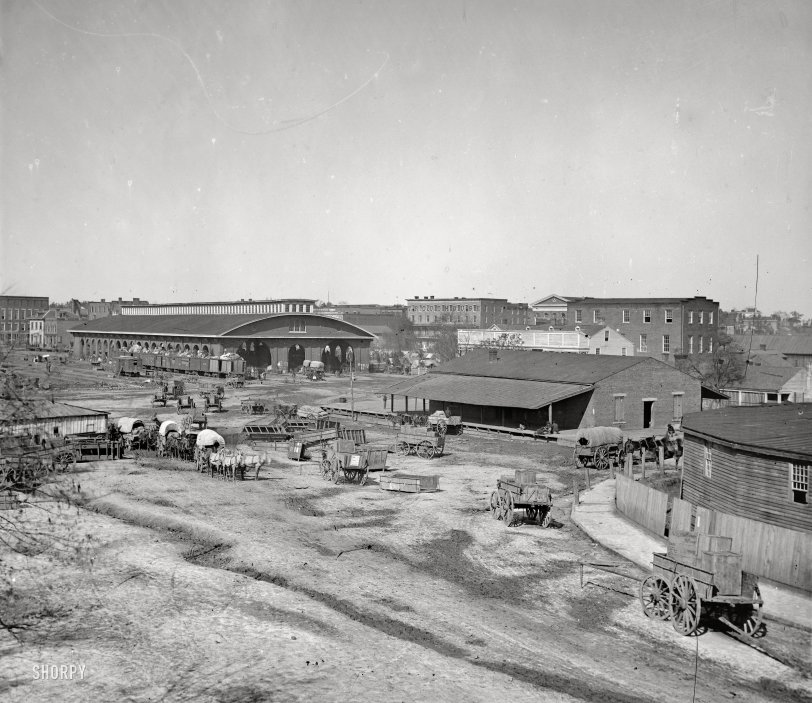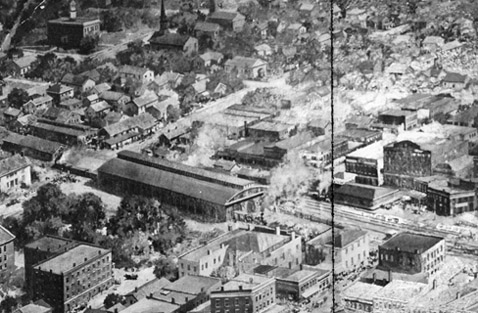


Framed or unframed, desk size to sofa size, printed by us in Arizona and Alabama since 2007. Explore now.
Shorpy is funded by you. Patreon contributors get an ad-free experience.
Learn more.

- Lofty addition
- In 1912
- Keenan Building
- Six years old
- Taken from the P.J. McArdle Roadway?
- It stood only 47 years
- Three track mind
- Incline to the right
- Reach for the sky, 1912 style
- No clean sweep
- Same Job Title, Same Face
- Sadly Lost
- Beautiful ...
- Where you get your kicks
- Aim High
- Pueblo Revival sisters
- Pueblo Neoclassicism
- Milk Man
- Regional dialect.
- Spielberg's inspiration
- Great Photo
- Loaf Story
- Do you still have the Rakes category?
- Could almost be a scene from the 1957 movie 'Hell Drivers'
- The Wages of Fear.
- Conspicuous by their absence
- Got Milk?
- All that aluminum
- No lefties
- Smoke 'em if you've got 'em
Print Emporium
Occupied Atlanta: 1864

1864. Atlanta, Georgia. "Atlanta railroad depot and yard; Trout House and Masonic Hall in background." From a series of photographs, "War in the West," made by George N. Barnard. Wet-plate glass negative. View full size.
"Sherman in Atlanta, September-November 1864. After three and a half months of incessant maneuvering and much hard fighting, General Sherman forced Hood to abandon the munitions center of the Confederacy. Sherman remained there, resting his war-worn men and accumulating supplies, for nearly two and a half months. During the occupation, George N. Barnard, official photographer of the Chief Engineer's Office, made the best documentary record of the war in the West; but much of what he photographed was destroyed in the fire that spread from the military facilities blown up at Sherman's departure on November 15."
That Concert
I am currently doing a lot of research on the history of theater in Atlanta. One of my sources states that Sherman attended 17 band concerts in the old Atheneum (noted in the photo) during the Federal occupation. Since the last info appears to be the date of Nov. 8, it seems to be a rough advertisement for one of those concerts. The Atheneum was on the north side of Decatur Street just before the Trout House when traveling east.
Hotlanta
Remember there were two fires in Atlanta -
The Great Fire of Sept 2 - this is the fire in GWTW and was caused when Hood burned up his ammunition trains -
The second fire was when Sherman left to March to the Sea on Nov 15 and the Union Army burned 'anything of value' to the Confederates and, well, things got out of hand -
From Sherman's Memoirs - About 7 a.m. of November 16th we rode out of Atlanta by the Decatur road, filled by the marching troops and wagons of the Fourteenth Corps; and reaching the hill, just outside of the old rebel works, we naturally paused to look back upon the scenes of our past battles. We stood upon the very ground whereon was fought the bloody battle of July 22d, and could see the copse of wood where McPherson fell. Behind us lay Atlanta, smouldering and in ruins, the black smoke rising high in air, and hanging like a pall over the ruined city. Away off in the distance, on the McDonough road, was the rear of Howard's column, the gun-barrels glistening in the sun, the white-topped wagons stretching away to the south; and right before us the Fourteenth Corps, marching steadily and rapidly, with a cheery look and swinging pace, that made light of the thousand miles that lay between us and Richmond. Some band, by accident, struck up the anthem of "John Brown's soul goes marching on;" the men caught up the strain, and never before or since have I heard the chorus of "Glory, glory, hallelujah!" done with more spirit, or in better harmony of time and place.
Blow-Up
Is it possible to enlarge the sign on the rear of the wagon in the center of the photo? Appears to be in sharp focus, but can't quite make out what it says, might be something interesting!

The Great Fire of Sept. 2, 1864
This is an excerpt from "Atlanta and Environs," Vol. 1, by native Atlanta historian Franklin Garrett. More here.
By midnight of September 1st most of the troops had left the city. But a few cavalrymen lingered. They had a special assignment. Hood had no idea of leaving behind, in usable condition, ammunition and military stores for the use of his adversary.
Shortly after midnight the citizens who had remained in the city were startled by a series of violent explosions from down the Georgia Railroad opposite Oakland Cemetery and the rolling mill.
Hood's ammunition trains, consisting of seven locomotives and 81 loaded cars, had been set afire to deny them to the Federals. As the flames reached each car, it exploded with a terrific din. Five hours were occupied in this work of demolition, which also included the rolling mill. Flames shot to a tremendous height and the exploding missiles scattered their red-hot fragments right and left. The earth trembled. Nearby houses rocked like cradles, while on every hand was heard the shattering of window glass and the fall of plastering and loose bricks. Hundreds of people flocked to high places and watched with breathless excitement the volcanic scene on the Georgia Railroad.
Fortunately all the citizens in the vicinity of the explosions had been ordered to leave their houses before the work of blowing up the ammunition trains commenced. Every building, for a quarter of a mile around was either torn to pieces or perforated with hundreds of holes by shell fragments. A new day was dawning when the last car let loose, and the last Confederate cavalrymen galloped out McDonough Road (Capitol Avenue) to rejoin Hood's retreating army.
View from the sky
Here is a bit of a painting of "Atlanta in 1864" by Wilbur G. Kurtz as reproduced in "Yesterday's Atlanta" by Franklin M. Garrett. Your photo appears to be taken from the City Hall (?) building in the top left. The Trout House can clearly be seen in your photo beyond the station and what the legend of the painting calls the City Park. It also says that the building with the sloping roof to the right of the Trout House is the Masonic Hall.
The photo and painting don't quite match. The photo shows clear ground in the foreground while the painting shows houses. At the right the photo also shows what appears to be a circular building (locomotive roundhouse?). This can also be seen right at the end of the street in a previous post.
This was taken from the right of the painting image looking left with the large Franklin Printing House building clearly visible on the right hand side of the street. The legend of the painting mentions a roundhouse, but doesn't actually seem to show it.
What's there now? I dread to think.

GWTW
This photo was obviously taken before Sherman destroyed Atlanta as his troops were leaving town. This photo of the open space in the yards might have been used as the inspiration for the panoramic scene in "Gone With the Wind" showing the multitudes of the dead and dying Confederate troops, no?
[This picture was taken after the Great Fire of September 2, which marked Sherman's arrival in the city. - Dave]
























On Shorpy:
Today’s Top 5